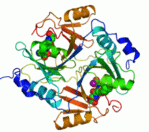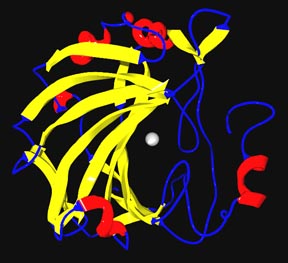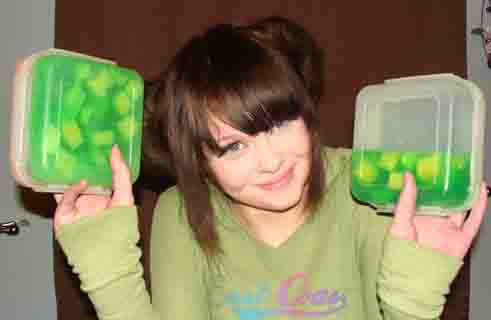 | ||||
What Is an Enzyme Catalyst?
Catalytic Proteins & Catalysis in Living Systems
CLASS NOTES from Science Prof Online
Enzymes are catalytic proteins that speed up chemical reactions. Without enzymes, biological reactions would occur at a much slower rate or not at all. Like other proteins, enzymes are made of long chains of amino acids held together by peptide bonds.
Enzyme Substrate Complex
Unlike inorganic catalysts such as acids, bases and metals, enzymes are very specific. Each type of enzyme can interact with one particular compound, its substrate.
Article Summary: A cell's ability to carry out essential chemical reactions separates the animate from inanimate. Without these biological catalysts, life itself would not be possible.
Catalytic Proteins & Catalysis in Living Systems
Ribbon diagram showing human carbonic anhydrase II. The grey sphere is the zinc cofactor in the active site.
You have free access to a large collection of materials used in a college-level introductory Cell Biology Course. The Virtual Cell Biology Classroom provides a wide range of free educational resources including Power Point Lectures, Study Guides, Review Questions and Practice Test Questions.
Bromelain Experiment: Container on left is Jell-O made with canned pineapple (gelatin is set). Container on right is Jell-O made with fresh pineapple (gelatin is liquid).
 | ||||||
SPO VIRTUAL CLASSROOMS
 | ||||||
SPO is a FREE science education website. Donations are key in helping us provide this resource with fewer ads.
Please help!
(This donation link uses PayPal on a secure connection.)
Page last updated: 10/2014
Lock and Key Model
Each type of enzyme has a unique 3-D shape, including a surface groove called an active site, which fits its target substrate much like a key fits in a lock. Other substances that don’t fit can't enter the active site and no reaction occurs.
Activation Energy
Enzymes work by weakening substrate bonds which lowers activation energy (amount of energy necessary for the reaction to occur). The enzyme then releases the product and is ready to begin the process again. One enzyme molecule can act over and over, transforming many substrate molecules.
In summary, enzymes are…
- proteins
- catalysts that accelerate cellular reactions
- not permanently changed in the reactions they mediate
- specific to what they will catalyze
- reusable
- usually named with an –ase suffix
Enzymes and Digestion
The food that you eat is exposed to enzymes from beginning to end. Amylase works in your mouth while you chew, breaking down starch (a big sugar) into smaller sugars. In your stomach, food is exposed to acidic gastric juices which contain the enzyme pepsin. Even in under highly acidic conditions, pepsin functions to split proteins.
Pancreatic juice released into the duodenum neutralizes the acid from the stomach, and contains an enzyme that continues to break down sugars; another that breaks down proteins; and a third, that digests fat. Once the food moves on to the small intestine, it has been broken down into tiny nutrients that the body can absorb and use for energy, repair and growth.
Why Does the Flesh of Apples Turn Brown?
Catechol oxidase (also known as catecholase) is the enzyme present in most fruits and vegetables. It facilitates the browning of cut or bruised produce by catalyzing a reaction between the molecule catechol and the oxygen in the atmosphere. The product of this reaction is polyphenol, the brown substance that we see accumulating when, for example apples or potatoes are exposed to air.
Fresh Pineapple and Jell-O™
Have you even tried to make Jell-O with fresh pineapple in it? If so, you’ve been disappointed. Here’s why.
Jell-O is made of gelatin, a processed version of a structural protein called collagen that is found in many animals, including humans. The gelatin you eat in Jell-O comes from the collagen in cow or pig bones, hooves, and connective tissues.
Pineapple contains the enzyme bromelain, which can digest protein. If fresh pineapple is added while you make Jell-O, the bromelain breaks down the gelatin’s protein, and the Jell-O will not solidify upon cooling.
Heat denatures, or changes the shape of proteins, and enzyme shape is crucial for the substrate to precisely fit into the active site. If instead of fresh, canned pineapple is used (cooked as part of the canning process), the bromelain is denatured and cannot facilitate the breakdown of gelatin. Using canned pineapple allows the gelatin to firm and set. See photo to left.
Sources and Resources
- Campbell, NA and Reece JB (2005) Biology. Seventh Edition. Pearson Education, Inc.
- Thorpe, P. ed. (2007) Biology 120 General Biology I: Laboratory Experiments & Exercises. Grand Valley State University.
- How Enzymes Work animation and quiz from McGraw-Hill.
- Enzyme Lecture Main Page from the Virtual Cell Biology Classroom.
- Enzyme Action and Hydrolysis of Sucrose animation and quiz from McGraw-Hill.
- What Is an Enzyme? animated tutorial from Northland College.
- Activation Energy and Enzymes animated tutorial from Pearson Prentice Hall, Inc.
- Enzyme Catalysis animated tutorial and quiz from WH Freeman.
 | ||||
FREE study questions to help students better understand Enzymes:
- Interactive Enzyme Tutorial and quiz from Life: The Science of Biology.
- “The Role Enzymes Play in the Body” from Enzymedica. These guys are selling supplements. I don’t endorse the supplement, but their video is very instructive regarding enzymes and digestion.
- “Assignment Discovery: Enzyme Catalysts” from HowStuffWorks, a Discovery Company.
- “Enzymes and Digestion” from About.com.
- Biochemical Pathways animation from McGraw Hill.
- Activation Energy animation from Pearson Prentice Hall.
- The Protein Song - song by MABS Music
The SPO website is best viewed in Google Chrome or Apple Safari.





